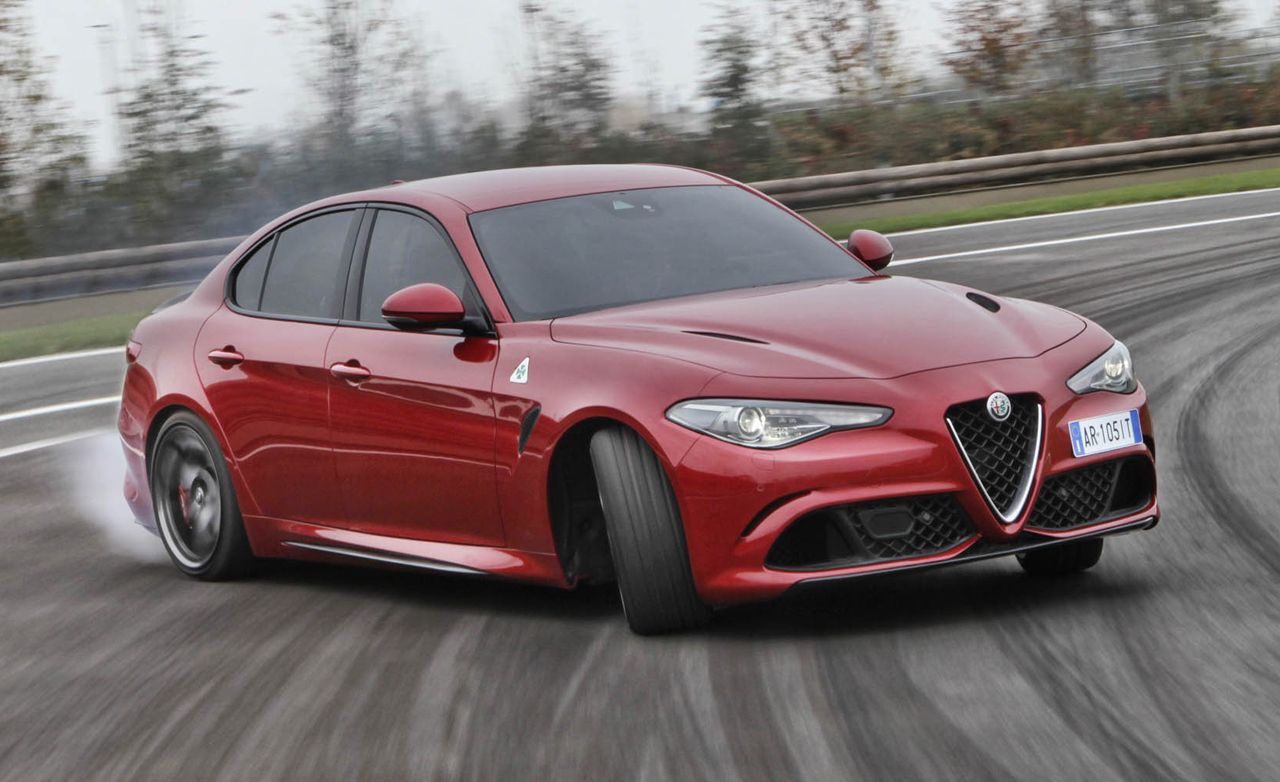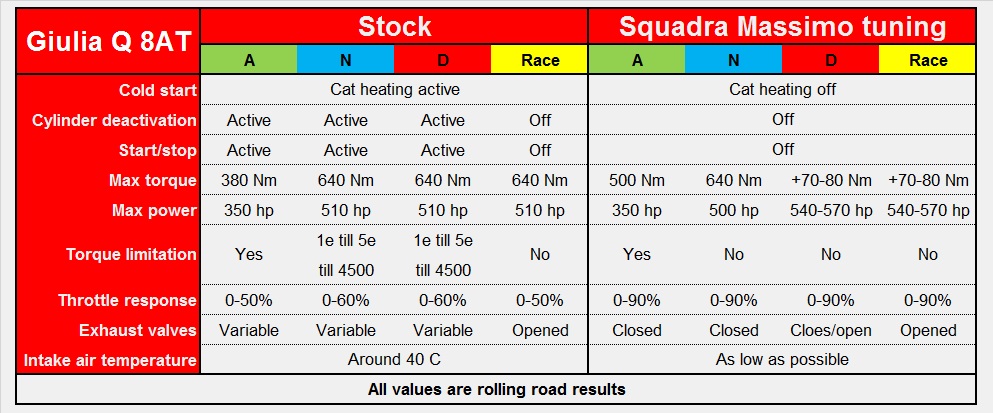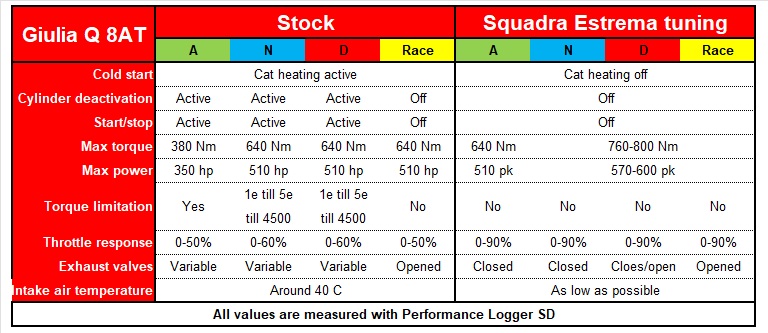








Security policy

Delivery policy

Return policy
Squadra Tuning is a renowned and respected chip tuning company in Holland specializing in the software tuning of cars from the FCA group. Due to this niche specialization, they are expertly aware of all technical aspects of these vehicles. They develop the engine management software from their technical knowledge, years of experience and are realistic about what is and what is not possible in terms of torque and power gains. They distinguish themselves by knowledge, quality and no-nonsense attitude. Their personal attention to the customer is also highly regarded. Squadra are trained/educated engineers (yes with engineering backgrounds and experience working with Alfa Romeo directly in there ECU tuning department) and all their tunes take time and testing to become what they are.
This tune is not only about more torque and power for the Giulia Quadrifoglio, although let's be real, you will get that but that said, this tune is much more about a better driving Giulia Quadrifoglio. Is that possible? Yes it is!

The cold start makes the eyebrows frown immediately. The engine cranks around nicely to start smoothly a few moments later. Starts just around 2000 revs and then drops to around 1500 to stay there for a while. And that’s not exactly subtle. The exhausts is screaming it out, accompanied by a noise that we personally can’t appreciate. Technically, this is called the “cat heating”. Due to environmental requirements, the catalytic converters must be brought to operating temperature as soon as possible. This is done by producing very hot exhaust gases. This is achieved by setting the ignition timing very late. We are going to save you details, but we can tell you that an engine/exhaust doesn’t like that. Every technician knows that you have to heat up metal gently not aggressively. The amount of fuel injected is also more than twice as much as it is actually needed under normal circumstances. In short, stress for engine and a waste of fuel. The “cat heating” MUST be switched off.
After our adjustment, the engine cranks the same as before but after it is started up it drops to 950 RPM within a few seconds. The late ignition is only for a moment to regulate the RPM back. Within a few seconds, the engine runs with a normal pre-ignition timing and with exactly the amount of fuel desired. The engine therefore runs more beautifully after a cold start.
Pretty soon after the first kilometers/Miles we were confronted with the cylinder deactivation. Under quiet low load conditions, half of the V6 is switched off. Not only in the A and N modes but even in Dynamic. As a result, the engine behaves like 3-cylinder with the corresponding annoying exhaust sound and vibrations. Some people also experience it as a resonance (exhaust drone) . A little gas on ensures that the engine returns to what it was designed to do, running on 6 cylinders. But of course you can’t keep pushing the throttle. That ends up at 307 km/h, the top speed of a Q. In short, the cylinder deactivation must be switched off.
The next annoying feature is the start/stop system. The conditions are such that the engine will switch itself off when you come for a standstill for a moment. As a petrol head there is almost nothing better than listening to the strokes of a running engine. And especially to that of a V6 Ferrari. In short, start/stop must be switched off.
We offer two levels of tuning. Massimo and ESTREMA tuning. Massimo tuning is are High Performance tune with all adjustments. For those who want a good boost in power/torque and take advantage of all the well thought out parameter changes.
The Estrema on the other hand is our Highest performance tune, boasting over 600Hp and a whopping 804Nm or 594ft/lbs of torque. It ecompasses all the same parameter adjustments as the Massimo tune.
Of course, all positions of the DNA+R button are thoroughly examined and tested. By default, the A-mode is clearly limited. Nothing wrong with that. The torque is mostly limited. Up to about 380 Nm at 2500 revs and then remains virtually flat. The power thus comes to about 350 hp at 6500 revs. We have made the shape of the torque curve a lot more natural. It peaks at 3000 revs at about 450 Nm. At 5500 revs, the old and new torque curve crosses each other. With these new values, the Q is a faster car in the A-mode and well considered the torque gradient feels more natural.
The Normal mode releases all available torque and power by default. At least that’s what one hopes. But beware, the first 6 gears torque is limited up to 4500 revs. At 3000 revs, about 130 Nm is missed. From 6th gear all engine torque is available. We have decided to remove that limit. In all gears, all the torque is now available. In the N-mode you could still contradict this decision but in the software this same limit also applies to the Dynamic mode. And that is unacceptable as far as we are concerned. However by altering a different map we limited the N-mode in all gears to about 550 Nm and 420 hp.
As described above, in Dynamic torque is also limited to about 4500 revs in the first 5 gears. Engine torque peaks at 600 Nm and just after 4500 RPM it quietly decreases to about 550 Nm at 6500 rpm which result in 510 hp. But you don’t always drive between 4500 and 6500 revs. It is precisely on country roads that the majority of the time you are under 4500 RPM and of course all the torque must be able to be present on call. That’s how it should have been…. This makes the Q a lot faster, especially under those conditions. This is particularly evident when one decides to switch to manual control of the ZF 8-traps.
Race mode is only adapted at one point, the accelerator pedal behavior. We find it incomprehensible that in Race mode, where one is completely reliant on one’s own traction control, the throttle reaction is made so wild that it is difficult to determine how much torque and power you want to send to the rear wheels. It’s going to be a marketing thing. No, as far as we are concerned, it is much more convenient to fully take advantage of the stroke of the accelerator pedal. By default, the powerful V6 releases all its torque and power at less than 50% of the accelerator. That’s half, the second half has no influence whatsoever. Almost an on/off switch. With our tuning, the entire torque is present at about 80% gas, the power at 90%. This gives a much better dosable feeling. The accelerator pedal is much better able to indicate what needs to be done.
What applies to the Race mode throttle reaction also applies to the A, N and D mode but to a slightly lesser extent. The maximum torque and power is reached far too early in the accelerator pedal. The accelerator pedal behavior from the A and N mode are software-linked. We have also made these much more docile compared to standard. The Dynamic and Race mode throttle reaction are not linked in the software. Yet we have chosen to make them equal. For example, the difference between Dynamic and Race mode is no different in terms of engine response. Of course, there remains a difference in switching behaviour and Traction Control and Forward Collision Control strategy.
For the exhaust valves we have also found another, very nice strategy. Stock these will open in A, N and D modes depending on the speed and engine load. In Dynamic a bit earlier than in Normal and that again a bit earlier than in Advanced Efficiency. However, if one gets a little enthusiastic, the valves can open for a moment and close again after shifting up to the next gear. That seems weird. Both outside and in the car. It’s really just causing disruption. Moreover, we often hear that one always wants the valves in Dynamic to be open. In Race they are always open by default. We have worked out the next new strategy. In A and N mode, the valves are always closed regardless RPM or load. This way you can still drive in peace. In Dynamic, one can choose whether the valves are continuously open or closed.
How? When switching from N to D, the valves remain closed. Now you can hear that the Ferrari V6 even sounds great with closed exhaust valves. Should this continue with more excitement, you switch from Dynamic to Race and a short moment twice. The Race mode is therefore only activated for a moment to return to Dynamic immediately. The valves are now permanently open in Dynamic. To close the valves, the DNA switch is switched back to the N-mode and possibly back to Dynamic.. That Alfa Romeo didn’t come up with this itself…..
But then there’s the big question. How much torque and power has the Alfa/Ferrari engineers left? By default, the specified power is almost exactly correct. The torque we measure is slightly higher than the promised 600 Nm. Not unusual. Only 6 to 7% more. About 640 Nm.
In particular, we expected a decent torque gain and a somewhat smaller power gain. But the facts are different. In terms of torque the increase is 70 to 80 Nm. The power increases by about 50 hp on average. We write ”average” because it depends. The 2.9 V6 is very powerful. External variables have the biggest influence on power and torque. Think of fuel quality, intake temperature, intercooler temperature, gearbox temperature and the duration of the engine’s full power supply. Under ideal conditions we measure about Massimo: 570 hp and 720 Nm/ Estrema: 600Hp+ and 804Nm Tq. If it gets warmer out and the fuel is not high grade/High Octane then you may see reductions in power which can also be seen on stock tuning.
For the Massimo/Estrema tuning we have another trick on our sleeve. This one we developed in 2017 and it is exclusive to Squadra. Many tuners look past this crucial element just pushing HP/TQ. We have our own strategy below for keeping the engine cooler while adding more power.
The 2.9V6 Q engine equipped with 2 liquid cooled intercooler. One for each cylinder bank. In the past, intercoolers were cooled by driving wind. Nowadays, this is done through an intermediate step. Coolant is cooled by driving air in via 2 radiators. This cool liquid flows through the two intercoolers to cool the sucked (pressurized) air.
To our surprise, through the engine management, the intake temperature is kept at about 40˚C/104˚F. As soon as the intake temperature drops below 40˚C/104˚F, the coolant circulating pump switches off. As a result, the intake temperature will rise again. If it is higher than 40˚C/104˚F, the pump will slowly start running again. As the temperature rises further above 40˚C/104˚F, the pump starts to run faster and faster. It’s a kind of thermostat principle.
We thought it was a bit silly. We have now succeeded in increasing the capacity of the intercooler by allowing the circulation pump to run earlier and at a higher rate. As a result, the overall temperature of the coolant drops and thus the intake air is further cooled. Cold air contains more oxygen and thus the engine will deliver more torque and power.
How much extra torque and power it generates is difficult to express in numbers. It depends very much on the outside temperature, the driving speed and the duration of the acceleration. In hot ambient temps (> 25˚C/77˚F) the influence is small. At temperatures <25˚C/77˚F, the effect is relatively large.
The Performance Logger.
This unique OBD tool allows you to precisely capture acceleration times and monitor the main parameters of the engine and powertrain. The communication takes place via the display on the instrument panel. With the finishing point, a Burn-out mode and Launch assist are programmed.
In the spring of 2020 we developed the Massimo tuning for the Giulia QV. In terms of maximum achievable power, we did not go further than about 570 hp compared to 505 standard and a torque of just over 720 Nm, compared to the 640 Nm standard measured on a Dyno. In short, 50 hp and 80 Nm more. What we also achieved with these gains was a greatly improved drivability of the Giulia Q. Standard can be compared to a rodeo horse. Wild, fast but difficult to control. Way too aggressive throttle response. By curbing this, the HIGH torque and power can be dosed much better. We give the driver a longer pedal to work with.
Along with the elimination of several other nasty character traits, the QV became a purebred racehorse. Very fast and with full control over the power. Our tuning turned out to be unique considering the fact that it
is now highly appreciated by Quadrifoglio drivers all over the world.
Pressure spikes and boost drops:
Of course, our 570 hp wasn't just plucked out of thin air. There was a reason behind it. Of course we looked to see if there was more in the barrel. There was, but we ran into an annoying side effect. When doing a full throttle run, it is indeed possible to generate more power by adjusting the turbo pressure higher. This works fine on a power bank, but not always on the road. The problem arises when you shift to the next gear at full throttle. In an automatic version, the engine will apply rev matching. Of course, the revs in the next gear have to be a little lower. The system does this by closing the throttle slightly, resulting in a pressure peak in front of the throttle. When this pressure peak becomes too high, the system intervenes by significantly reducing the engine's turbo pressure. As a result, a power decrease of about 100 hp in the next gear. However, no error is generated. Which is remarkable, because there is certainly a kind of emergency run. Of course, we spent a lot of time at the time trying to figure out what exactly was causing these boost drops. To our great frustration, that didn’t work out at the time. With about 560 hp, the pressure peaks were of such a level that this phenomenon did not occur.
But still......
At the end of 2023, it started to itch again. For the first time, there was a colleague tuner who told the same story. He actually was the first colleague who shared our finding.
Many other well-known tuners did not recognize the phenomenon or ignored it. We have often been approached by QV owners who had the QV tuned elsewhere. They suffered from boost drops after upshifting. One of them used our Performance Logger. The LOG files confirmed the issue. We have been able to help some of these customers with our 570 hp tuning (Massimo).
We went looking for more!!! As is often the case, the solution afterwards is always easier than previously thought. You just have to know where to find it. By increasing the turbo pressure step by step and at the same time carefully studying the Performance Logger LOG files, we found the cause. This paved the way for more power. But the goal of 600 hp was not so easily within reach as many might think.
According to the booklets, the Q engine delivers its 510 hp at 6500 rpm. But what is striking is that after 6500 the power drops slightly and then, at 6800-7000 rpm, there is an extra peak. Often just a little higher than 510 hp. This indicates that there is more in the barrel. The rev limiter is standard around 7350 rpm. That too is special. 850 rpm later than the rpm of max power. Normally, those two speeds are closer to each other. F154 Ferrari V8.
The Quadrifoglio engine is derived from the F154 3.8 V8 of the Ferrari California and 488. Engines that deliver their top power at 7500 and 8000 rpm respectively. Not at 6500 like the Q motor. With small steps we started to increase the revs. See how the turbo pressure holds up in relation to the control of the Wastegate (boost actuator). After all, a turbo should never function at 100% (closed wastegate) of its ability. So we intent to stay away from that point. But even more important is the ignition behavior. It next to mandatory to maintain the set value, otherwise too much stress will arise according to our philosophy. At least RON98/93 octane is the only thing the Q will be administered. The result? Our goal of 590 to 600 hp was reached around 7500 RPM. The rev limit is fixed at 7800 rpm. 800 Nm of torque
But we weren't just looking for more power. Some extra torque would be nice too. To achieve this, we had to make a special adjustment in the software. Normally, we don't like to make such an adjustment because a so-called circular map has to be adjusted. These are two maps of which the outcome of one must be able to be filled in in the other with the same result as a result. If this does not go well, after a while you will get very strange phenomena in the engine behavior. So this has to be done wisely and prudently. The torque could thus
increase to 780 to 803 Nm around 4200 rpm.
But there was another hurdle that had to be overcome at the same time. The 8-speed ZF automatic gearbox. Since the beginning of 2023, we have been able to make it our own. As standard, it shifts to the next gear at about 7100 rpm, provided it is driven in automatic transmission. In manual, it does not shift automatically in Dynamic or Race. Because the engine is limited to 7800 rpm, it would reach the absolute limiter of the gearbox at 7600 rpm. Unfortunately, that limiter cuts hard. Emergency running and a restart is needed to get it back to its positive The big question is how many revs the ZF can make. A survey among specialists shows that this is 8000 rpm. We therefore set the absolute limiter to 7900 RPM. But don’t be afraid. In all positions of the gearbox (automatic and manual) the gearbox now
shifts to the next gear at max 7600 rpm. In the lower gears, it happens sooner because the engine always revs a bit during upshifts. Otherwise, the 7900 could still be reached.
In short, the Estrema engine tuning MUST always go in combination with our Estrema gearbox tuning for the Quadrifoglio. Unless you own a manual version.
The Performance Logger.
We already mentioned our Performance Logger. In the time that we have developed the Estrema version, the Performance Logger has also been developed considerably. The advantage is that we can measure the signals from both cylinder banks (there are two ECUs) at the same time. We added several parameters that were important to monitor the enormous power. In addition, we have even been able to make the determination of torque and power much more precise. This calculation consists of 3 parts.
1) the rolling resistance power = the ability to travel at a certain speed
2) the acceleration power = accelerating mass
3) the inertia power = starting the rotating mass. This manifests itself in an equivalent mass that counts as a correction for the accelerating power per gear.
In theory, the engine should show about the same power to the crankshaft in every gear. The Performance Logger now shows this. For us, this is proof that our calculations are correct and that we do not need a wealth bank. After all, a dyno has a major disadvantage. The temperatures of the intake air and engine (oil) are difficult to control. This is much better on the road.
With the Estrema tuning, we have given the A-position the stock torque and power. The Performance Logger shows these values almost exactly. N, D and Race give the tuned torque and power. Everything has to be warmed up nicely. Engine, gearbox and also the differential oil. Not too high outside temperature, not too high air humidity. Nice flat tarmac, exhaust valves open.


RPM limiter unchanged 6800 RPM (Massimo)
RPM Limiter to 7800 RPM (Estrema)
Improved cold start running
Cylinder deactivation disabled
Start/stop disabled
Increased torque in A mode
Torque limitation removed in D mode
Throttle response is improved, more control with more pedal dosability from 0-50% to 0-90%
Modified exhaust valve opening logic
No Emissions components/devices have been modified.
*Tuning is a non-returnable product that is classified under our terms and conditions as "electronic components". There are no returns. No exceptions.
*ORIGINAL ECU's Must be shipped to us even if you want to clone ECU's. DO NOT SEND US ECU'S FROM ANOTHER VEHICLE UNLESS THE ORIGINAL ECU'S WILL ACCOMPANY THE UNKNOWN ECU'S.
*93 or higher octane Fuel. 91 octane will produce slightly less power.
Suitable for all Giulia/Stelvio 2.9L Engine -EXCEEDS ALL FIAT OIL SPECIFICATION (Z2 and GH2)